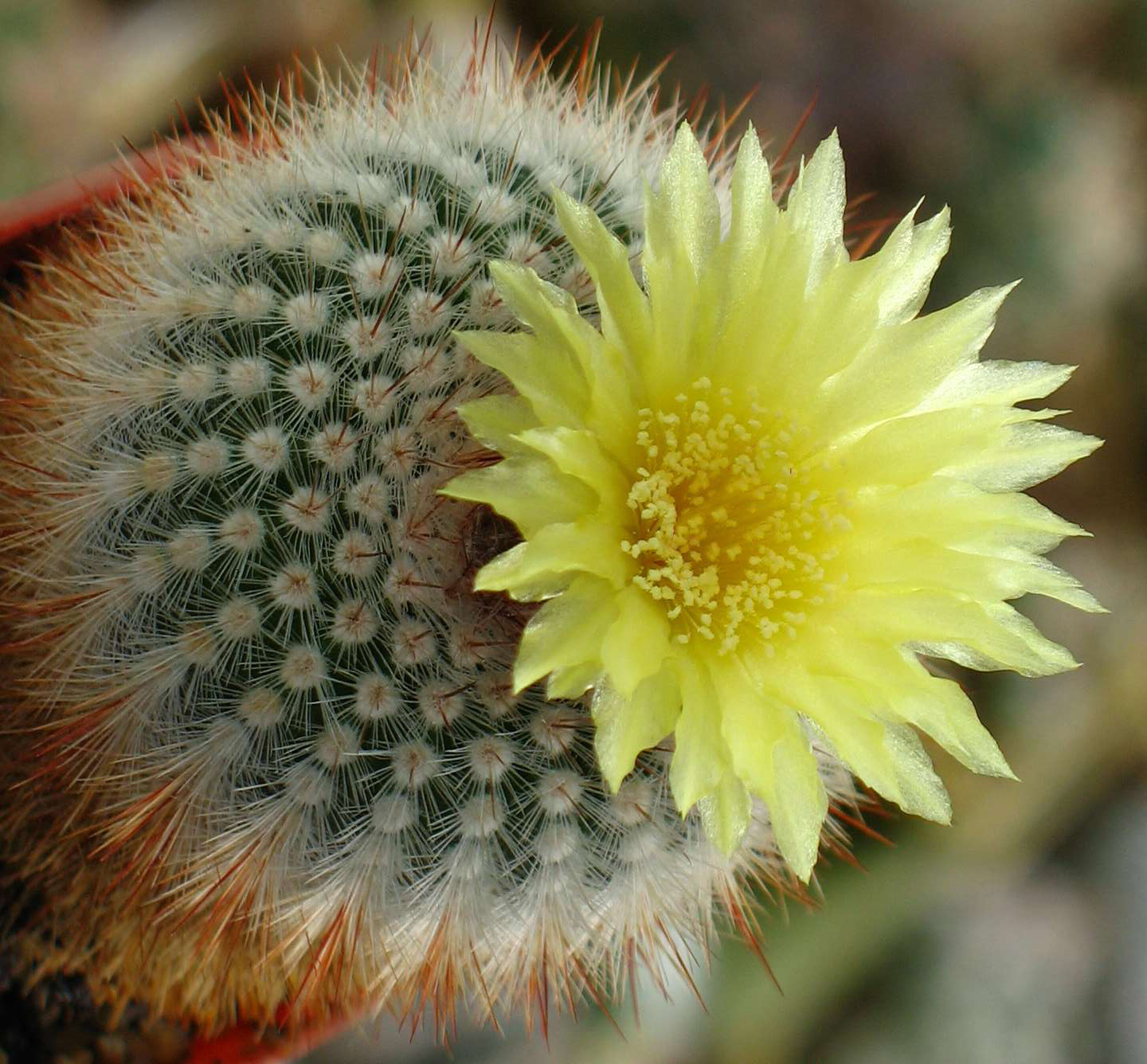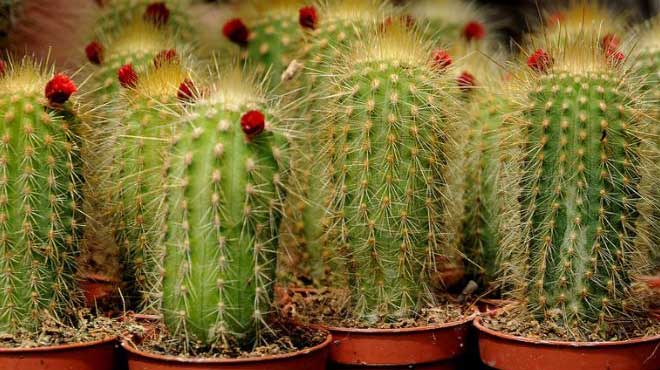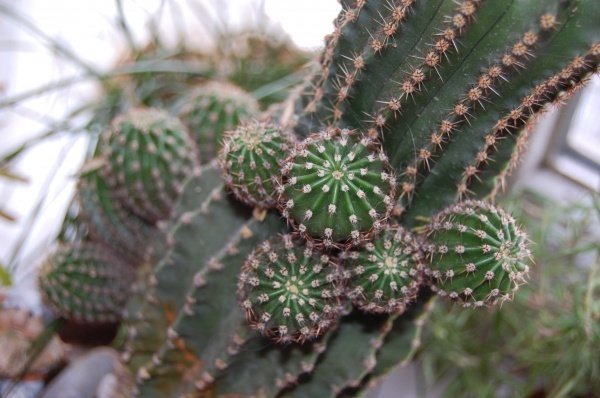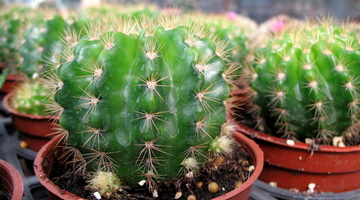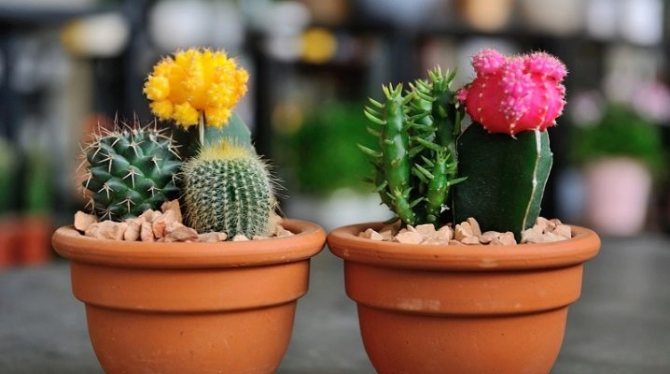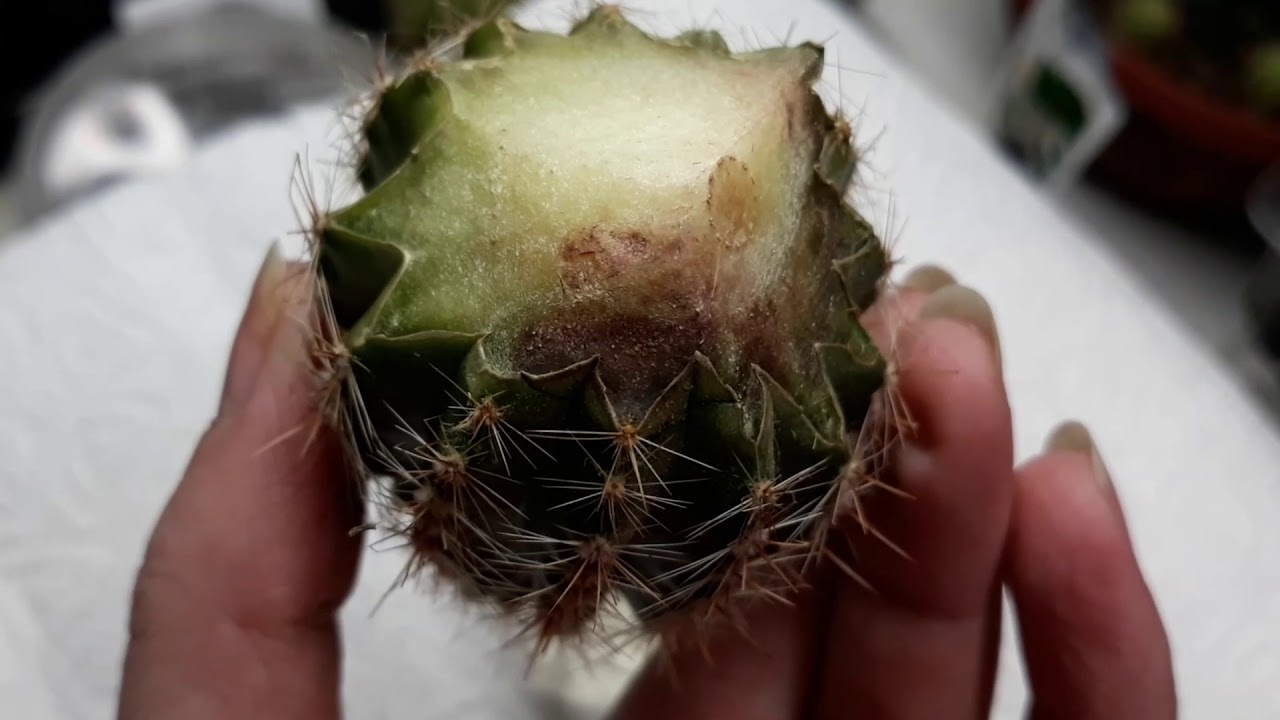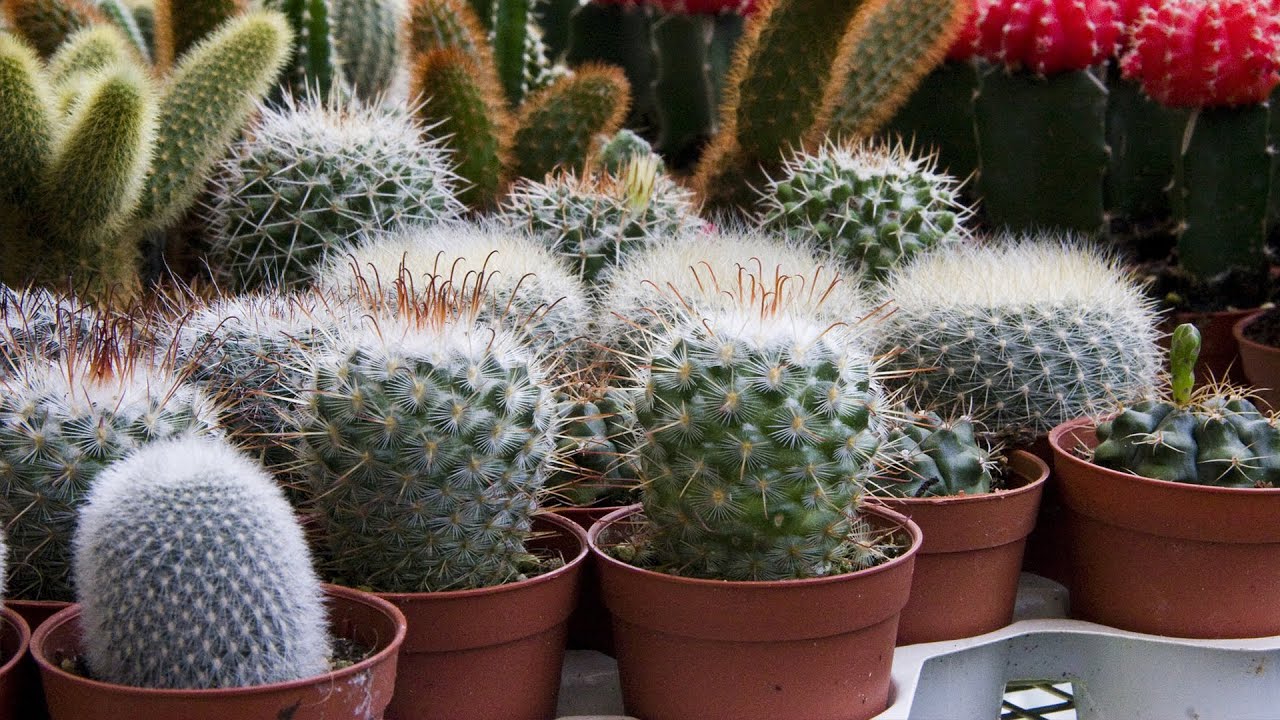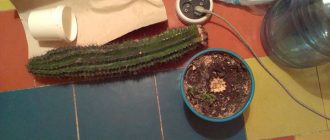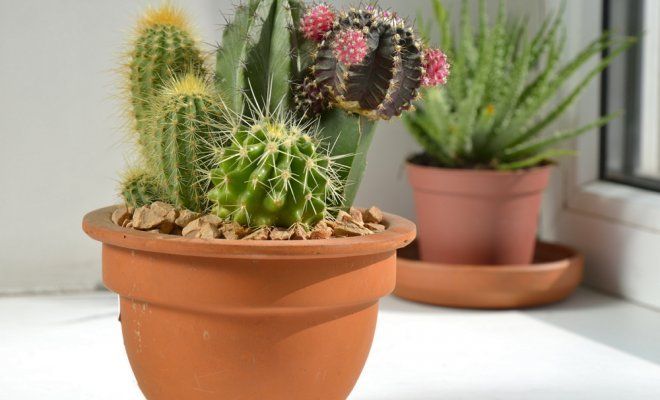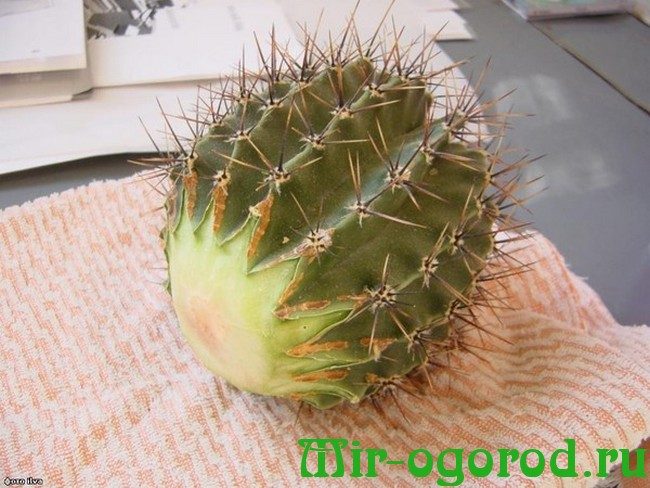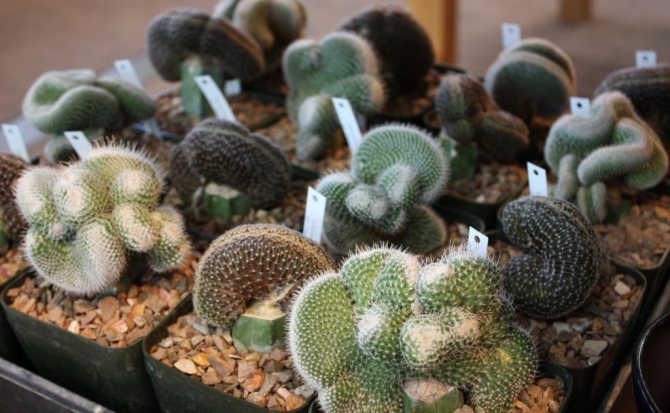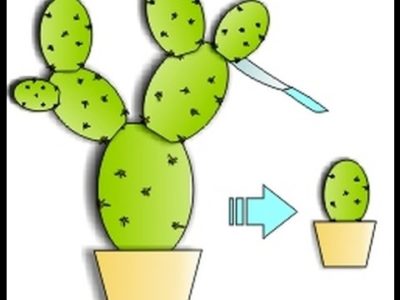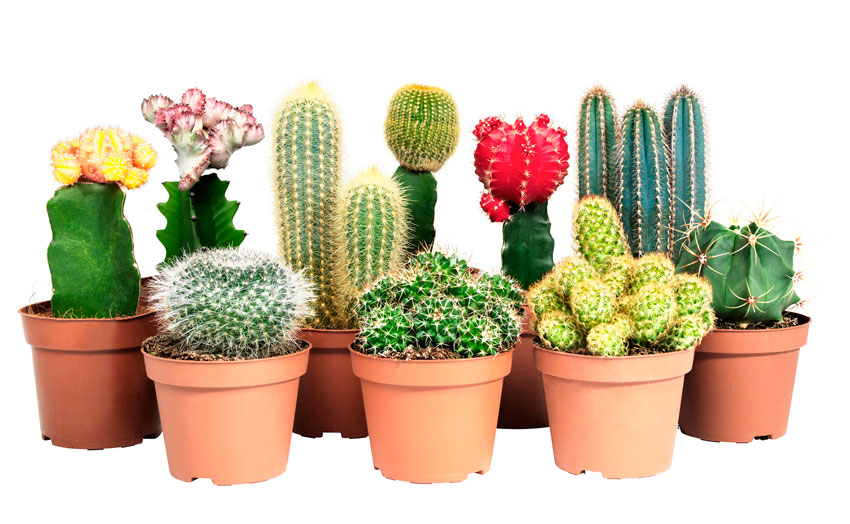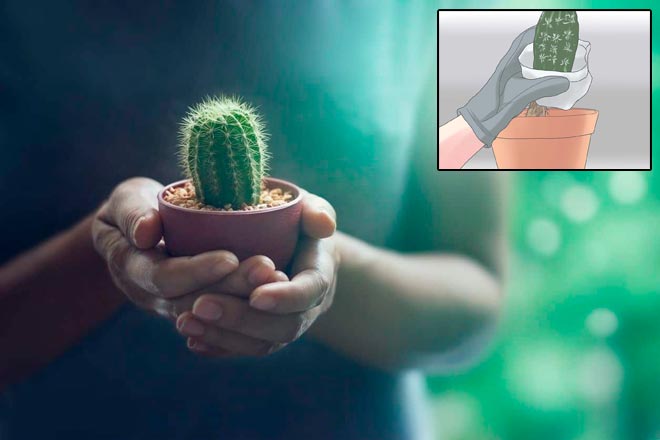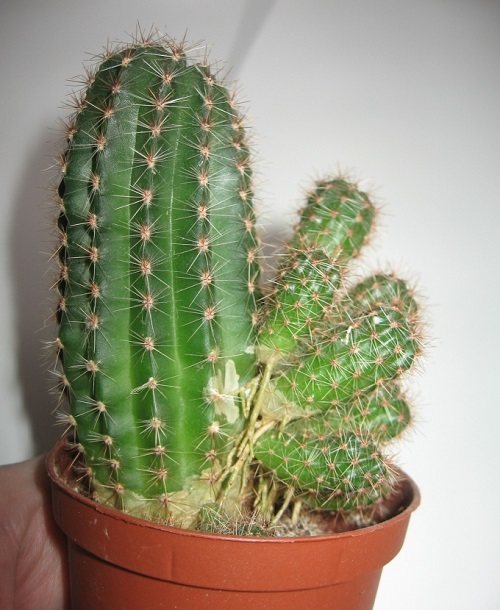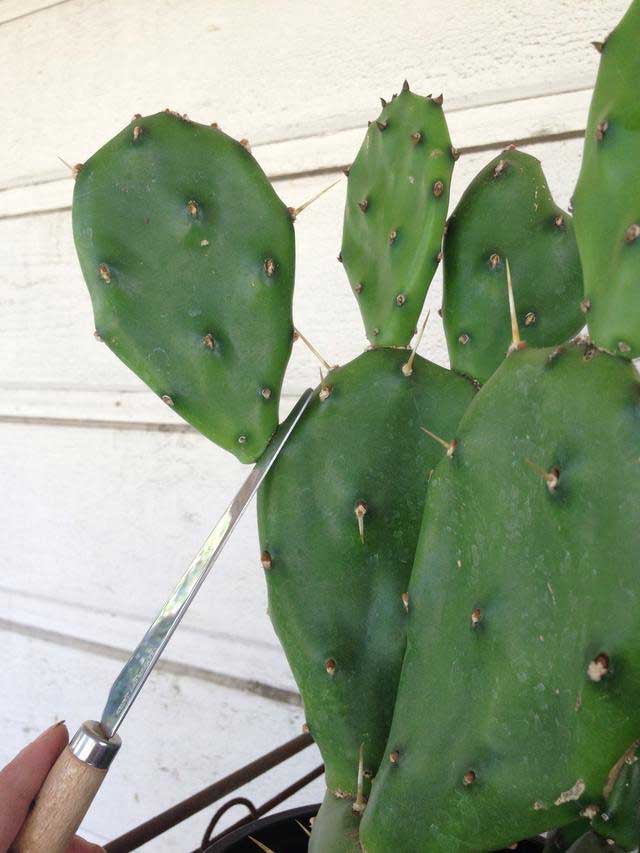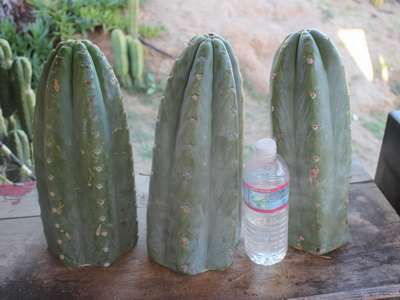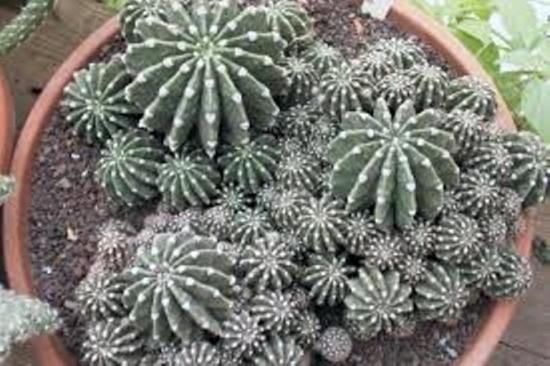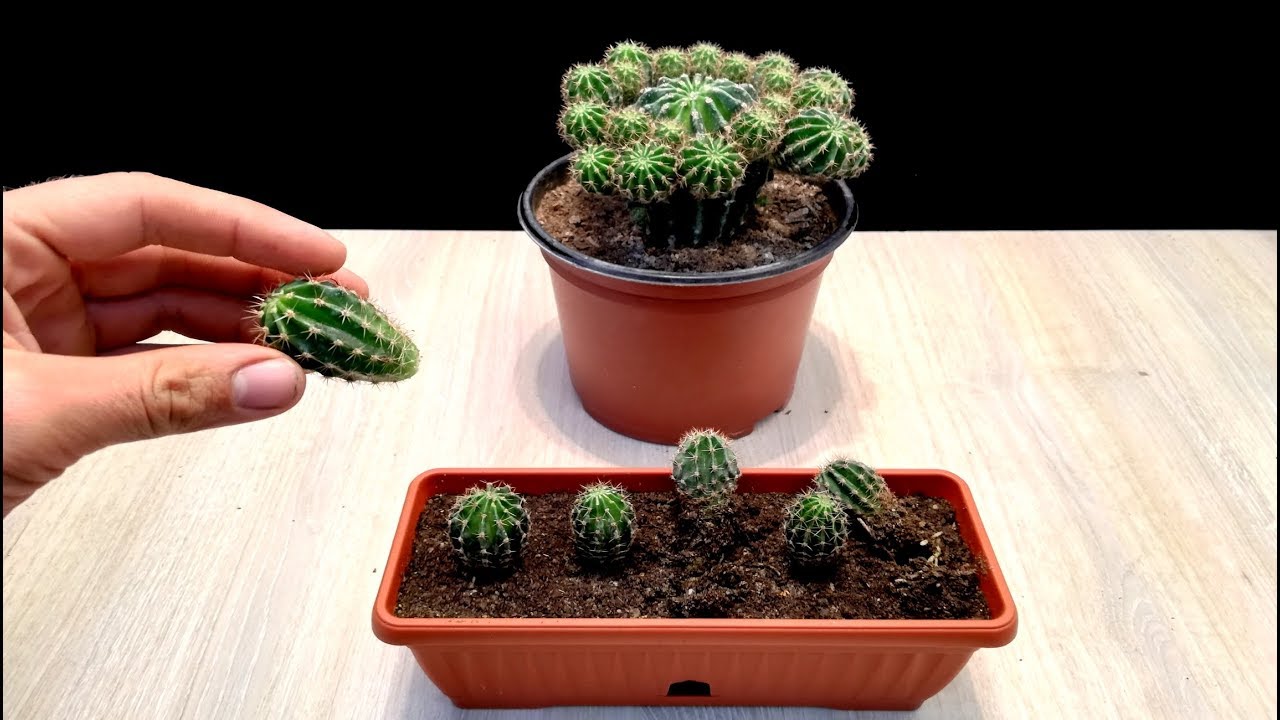Cactus pot
First of all, it is recommended to focus on the size of the root system of the flower. And since in the case of cacti, most often it is necessary to plant planting material without roots, it is more convenient to use small cups or boxes with small individual cells.
What material the tank is made of is essentially unimportant, you can not only take iron containers. The most commonly used tanks are plastic or ceramic.
The presence of drainage holes in the pan is mandatory, the accumulated water should be removed. As a permanent residence for cacti, it is better to take shallow containers, most cactus have a superficial root system.
Propagation of cacti by seeds
Seed propagation of a cactus is not always effective. In many species of these plants, the seeds are very small, do not germinate well or are very capricious and require strict adherence to many conditions - from temperature, light and humidity to the composition of the soil.
But if your cactus seeds are fresh, large, healthy and you are confident in your skills and abilities of a florist, you can try to master this procedure.
You can sow cactus seeds in the ground, starting from February-March. For disinfection before sowing, it is better to soak them for a short time (8-10 hours) in a slightly pink solution of potassium permanganate.
Soil for cacti is suitable from a mixture of peat and coarse sand (2: 1), previously calcined in the oven or spilled with boiling water. A drainage layer is necessarily poured onto the bottom of a disinfected small pot, and only then it is filled with soil mixture.
Cactus seeds are spread directly on the surface of a well-moistened and slightly compacted soil at a distance of at least 2 cm from each other. It is not necessary to sprinkle them with soil on top - this can only be done for large seeds.
The container with seeds is covered with glass or foil and placed in the warmest place, remembering to ensure that condensation does not accumulate on the inner surface of the shelter. The night temperature in such a greenhouse should be several degrees lower than the daytime.
Seedlings will have to wait from several days to several weeks - depending on the selected type of cactus. As soon as the sprouts appear, they need to provide a sufficient amount of light, it is recommended to move the film or glass from time to time so that there is a constant flow of fresh air, and then completely remove it. Of course, a place with young growing cacti should be protected from drafts and direct burning sunlight.
As for the issue of watering the seedlings, here you need to be very careful and careful - both lack and excess of moisture are equally destructive for growing cacti. The soil should ideally be slightly damp at all times, but not wet.
The grown cacti, in which thorns have begun to break through, can be transplanted into individual pots - the plants are carefully transferred with a lump of near-root soil, in no case, when planting, without deepening the root collars.
Opuntia varieties
- Perhaps the most popular among lovers of home plants is the fine-haired prickly pear. During the flowering period, it is densely covered with bright yellow flowers of medium size. Even her golden thorns look very attractive.
- By the way, to the question of prickly pear - a houseplant or not: the garden queen of cacti can be grown both at home and in open space, since she is not afraid of winter cold. Under a thick layer of snow (just think!), It successfully survives frosts up to 35 degrees.If you live in areas with little snow, then cover the wintering prickly pears in autumn with a thick film.
- Indian prickly pear (fig) blooms very profusely, and in place of each flower wonderful edible fruits ripen, outwardly similar to figs. They taste like pear and strawberry.
- The Berger variety blooms with rich, bright red flowers.
- White-haired prickly pear pleases with small bright yellow flowers that smell amazingly nice. This cactus will also give you delicious fruits.
- Eeyore common in summer is covered with large yellow flowers.
- The Subulat species is very different among its congeners in its atypical form. Its thick stems grow strictly perpendicularly, their number increases over the years. The result is a lush bush of rectilinear stems.
- The main prickly pear is characterized by the splendor of its crown. Over the years, it takes on the appearance of a bush.
- How beautiful the Gosselin prickly pear looks! In adulthood, it is a dense bush. It blooms in large, very fragrant, bright yellow flowers. Its stems can be green or bluish in color. More precisely, the blue of the stems gives a light bloom. If you erase it, the surface of the stems will turn out to be green.
- The cactus queen, spread with her flat stems, spreads along the ground. In mid-July, these stems are covered with bright yellow flowers. Habitat - hot countries.
- Cylindrical prickly pear pleases with orange, pink or red flowers. It can reach a height of six meters. This happens if the plant grows outdoors. In the room, the variety reaches a maximum of 2 meters in height and does not bloom very densely.
How to plant a cactus: the choice of soil and container for planting
Soil for cacti can be made at home using components such as:
- sod soil;
- garden or forest land;
- humus;
- river sand;
- brick chips;
- charcoal;
- pebbles, gravel;
- zeolite (processed clay).
In order not to waste time preparing the soil before planting a cactus, specialized stores provide the opportunity to purchase a ready-made soil mixture, which includes all the necessary components:
Blooming cactus
- high-moor peat (product of decomposition of dead parts of herbaceous, deciduous and coniferous plants, as well as moss);
- low-lying peat (a mixture of the remains of rotted plants and animals, which includes many nutrients);
- humus;
- leafy soil (light, loose soil is obtained as a result of rotting of fallen leaves);
- coarse river sand;
- gravel or fine crushed stone;
- charcoal and broken brick mixed in equal proportions;
- expanded clay (used as drainage);
- vermiculite (absorbs excess moisture).
Important! Organic fertilizers are not applied to the composition of the soil, because they can make the plant loose, elongated, worsen its appearance, and can also provoke the appearance of cracks and scars on its skin
Cactus baby without roots
In no case should be added to the soil, in order to avoid the death of the plant:
- bird droppings;
- manure;
- sawdust.
The choice of a pot must be approached no less responsibly and pay attention to:
- the material from which the container is made (for cacti, anything except metal is suitable);
- the size of the pot (it is chosen 2 cm larger than the previous one);
- the shape of the container.
Note! When choosing a pot, take into account that not only roots and soil should fit in it, but also drainage, which prevents root decay from an excess of moisture. To choose the right container, you need to carefully remove the cactus from the previous pot, spread the roots and carefully examine the root system for damage or pests
If the roots are short and thin, then a wide and shallow pot is suitable for the plant. If the roots are long and have a pronounced stem, then the capacity should be deep and narrow.
To choose the right container, you need to carefully remove the cactus from the previous pot, spread the roots and carefully examine the root system for damage or pests. If the roots are short and thin, then a wide and shallow pot is suitable for the plant. If the roots are long and have a pronounced stem, then the capacity should be deep and not wide.
Children on a cactus
Planting cactus babies
This is the easiest and fastest way to reproduce these succulents, which does not require special skills and knowledge. It is enough to adhere to a certain algorithm and take into account the features of these unusual plants:
The best time for separating and planting children is spring and summer, during this period the plant actively grows and develops, takes root more readily and the healing processes proceed faster.
It is important to prepare a suitable soil mixture. It can be a ready-made substrate intended for cacti and succulents or a mixture made by hand from river sand, humus, turf and peat
All ingredients are taken in equal amounts, except for peat, 0.5 part is enough.
Drainage is placed at the bottom of the pot - foam or gel balls, broken brick, small pebbles or other material that will not allow moisture to accumulate in the tank.
It is necessary to choose the strongest shoots, as a rule, they grow closer to the top of the parent specimen. They should be large, without signs of damage or disease.
Cut off children should be left for several days - from 3 to 7, left in the air, to dry, so that the places of the cuts are slightly tightened. The place should be dry, warm and cool. It is not worth worrying, in nature they can be on the ground for a long time, waiting for suitable conditions for rooting, while maintaining their viability.
If a shoot is separated with roots that have already appeared, then it can be immediately rooted in a slightly moistened soil. A young planting should be kept away from direct sunlight, lighting should be diffused. The crumbs should be watered as the top layer of the soil dries.
Vegetative propagation: how to propagate cacti with babies and cuttings
Vegetative propagation of cacti - by cuttings or layering - is easier to accomplish. Some species have evolutionary adaptations for such reproduction - lateral shoots that are easily separated from the mother plant - children, often equipped with tenacious spines. In nature, thorny babies, like the fruits of a burdock, are carried by animals (in general, in nature, vegetative reproduction in cacti is quite widespread). Usually, the junction of the baby with the maternal stem is very narrow and already at an early age is supplied with rudimentary roots. When children reproduce cacti, rooting is not a problem - just put the baby on any wet substrate, and the root system quickly develops. The plant grown from the baby is practically no different from the mother. But before you propagate a cactus with children, keep in mind that this method, used for a long time, leads to a decrease in the quality of plants and at least periodic renewal from seeds it is necessary to maintain the normal state of the species in culture.
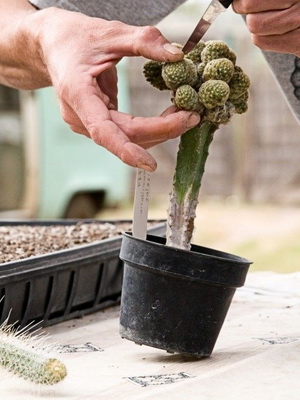
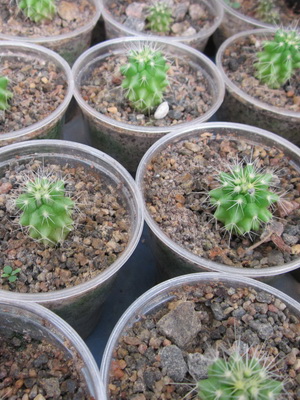
The situation is more complicated with the vegetative propagation of cacti that do not give children. Fast-growing species (epiphytic, cereus, opuntia) are propagated by cuttings - pieces of the stem. Before propagating the cactus by cuttings, choose a healthy, ripe, but not old (not lignified) shoot or section of the stem and cut it off with a sharp disinfected tool. The cut on the parent plant is best done in the narrowest place (for segmented plants - between the segments) and on the cuttings it is better to leave the cut in the narrowest place, but for cereus and epiphyllums it is recommended to make a new cut at a wider place.Places of cuts on the plant and cuttings are dried (in the sun, in a dry atmosphere, sprinkling with disinfectants and preparations stimulating the formation of roots). Cuttings are kept dry, not in the open sun, in an upright position with the cut down. After the cut site has dried (no earlier than three days), rooting can begin. In general, cuttings last a long time - several months. Cuttings of some species, for example, epiphytic cacti, root well even in a thin layer of water, others form roots simply in the air - placed in an empty glass or pot. But usually, for the propagation of cacti, cuttings are rooted in a moist, preferably disinfected substrate (sand, mineral chips, peat, sphagnum or ordinary earthen mixture). After the development of the root system, the plants are planted as in a conventional transplant.
For vegetative propagation, sometimes children and shoots for cuttings are grown artificially, cutting off or damaging the top of the stem. But the plants obtained in this way are always of lower quality than those grown from seeds.
Plants that have lost their roots or the lower part of the stem are also rooted; tops of old or disfigured plants. This is a very difficult and ungrateful matter: due to the extensive plane of the cut, the plant is difficult to protect from decay, but even with successful rooting, its normal form, especially in the place where the root passes into the stem, is often not restored. In addition, such plants, despite their external attractiveness, are characterized by reduced viability.
Some species produce many basal offspring and underground stolon shoots, on which new plants are formed. In an overgrown dense bush or curtain, it is easy to find plants that are already independent, rooted and have lost their connection with the mother stem. They can be easily separated (especially when transplanting) and immediately dropped into a separate bowl.
Watch a video of cactus breeding in various ways at home:
Methods and rules for vegetative breeding
Vegetative cultivation of cacti involves the use of "babies" and cuttings obtained from strong healthy plants. These methods are among the most simple, so even a novice florist can use them.
"Children"
This method of breeding cacti is allowed to be resorted to all year round. However, it is best to propagate plants by "children" in the spring-summer period. If it becomes necessary to grow a young cactus from a shoot in autumn or winter, the plant should be provided with sufficient illumination and optimal temperature and humidity conditions.
For growing "kids" use a special substrate for succulents or soil mixture prepared from the following ingredients:
- fertile and loose garden soil - 1 part;
- clean coarse sand - 1 part;
- peat - 0.5 parts.
Crushed charcoal and / or fine foam fractions are introduced into this mixture as drainage elements. The drainage should also be poured into the bottom of the container in which the shoot will be grown. Here you can use crushed expanded clay, brick chips or pebbles as drainage.
A convenient plastic container of sufficient width and depth is suitable for growing cacti. Given that these plants have a very strongly developed root system, small and small containers are not suitable for them. At the bottom of the selected container, holes must be made to drain the water.
Having prepared everything you need, you should carefully examine the donor plant and carefully separate the largest and strongest shoots from it. In most species of cacti, "babies" by the time of separation already have the rudiments of roots, so it will not be difficult to disconnect them from the donor plant
In some cases, when the "baby" has no roots and is tightly attached to the mother plant, it is cut off with a sharp blade.After this, the cut sites are treated with activated carbon powder, and the process itself is placed in a dark place for a couple of days. When the cut site dries up a little, they start planting the appendage.
Before planting, a shallow hole is made in the surface of the substrate and the "baby" is placed there with a cut down. In this case, you do not need to dig in a shoot without roots.
If the "baby" has root rudiments, they are carefully straightened with a thin stick, the roots are lightly sprinkled with sand or vermiculite, and the soil is gently pressed down, fixing the process in a stable position. The roots should not be heavily covered, otherwise they will not be able to fully develop
The container with the "babies" after transplantation should be removed for 2-3 days in a dark place. The first watering of the surviving shoots is recommended not earlier than after 5-7 days.
The fact that the "baby" feels good after the transplant will be evidenced by her healthy appearance and gradual growth.
Cuttings
Types of cacti that do not form shoots are bred by cuttings. Only healthy and well-developed specimens are suitable for this method.
In this case, you can get a viable cutting by cutting off the top. Cutting is carried out with a tool with a sharp blade, pretreated with any alcohol-containing agent. The place of the cut on the plant and the cuttings is also disinfected. In addition, the cut of the cutting is additionally treated with a solution of a rooting stimulator.
After cutting, you cannot immediately plant the cutting in the substrate. After processing the planting material with disinfecting and stimulating drugs, it is removed for several (5–6) days in a dry and dark place, fixing it in an upright position. This procedure is necessary so that the cut site can dry out a little. This is an important condition for the prevention of rot.
The planting of the cuttings is carried out in the same way as the planting of "children", lightly sprinkling the lower part. Cuttings that are too long are fixed on a wooden or plastic support. To root the apical part of the cactus, use the same composition of the substrate as in the case of planting the shoots.
Reproduction
Sooner or later, everyone asks the question: How to propagate a cactus at home and what is needed for this? " The question is interesting and important. There are several ways:
- Seeds
- Children
- Cuttings
Let's consider each of the ways:
Seeds
In order to grow a cactus from seeds at home, you first need the seeds themselves. You can take them in two ways - in the store or after your pet has flowered. The process itself is quite long, requiring strength and attention. Planting is best done in mid or late February to get into a period of active growth.
So, you have the seeds, now you need a small greenhouse. You can buy it in the store, but in order not to spend money, the packaging from the cake, always with a lid, will do. Now the greenhouse needs to be treated with a solution of potassium permanganate so that mold does not form in the future. And, of course, we need soil. For seeds, it is best to buy a special soil, "homemade" will not work here.
At the bottom of the greenhouse, a layer of earth is poured, 3-5 cm thick. Then, it must be watered with water, the temperature of which should be 40-45 degrees Celsius. After that, using a thin object, such as a toothpick, make small holes at intervals of 1-1.5 cm and spread the seeds in them. You don't need to sprinkle anything with earth, the seeds should be open. When everything is ready, cover the greenhouse with a lid or cling film, and put it on the windowsill.
Typically, seeds begin to germinate within the first 10 days. In the future, the cover (film) will need to be opened so that the young "cacti" breathe fresh air. When your "kids" are 3 months old, they should be seated in separate pots. We wrote a little above how this can be done. Read more about how to grow a succulent plant from seeds at home.
Reproduction by children - processes
This is another fairly popular method. For the reproduction of a cactus by children, it does not take much trouble and effort. This method is considered to be the simplest. A baby is a process that grows on the cactus itself. It can be one, and maybe several pieces. For reproduction, it is best to take babies that grow closer to the top, because they are stronger and more enduring, which means they will grow without problems.
To take the baby, you can use a cloth or tweezers. Gently grasp the appendix and pull it towards you. He should easily separate, but if this did not happen, then it means that he has become entrenched on the mother plant. In this case, it is better to try to take another shoot, so as not to inflict "injury" on the main cactus.
The process of transplantation of the appendix is correct, subject to the basic requirements:
- The shoot must be dried on a clean and dry sheet of paper, mainly in a dark place. The duration of the healing of wounds formed in the process of cutting the appendix should occur within one to two weeks;
- After the lesions have healed, you can begin the rooting process;
- Transplanting, as a rule, should take place using small pots in order for the plant to take root;
- It is imperative to pour drainage into the bottom of the pot;
- The shoot must be rooted in a substrate, mostly wet;
- So that the soil does not lose a lot of moisture, you can sprinkle it with small stones;
- After a period of 1-2 weeks, the cactus will take root.
So, when the baby takes root, it needs to be planted. To do this, use a small pot and special soil.
It is important that the ground should not be too wet. Next, you need to make a small and shallow hole and put the baby there
Do not think that it has no roots, they are, just some are smaller, while others, on the contrary, are long and large. In a few days, the baby will start and will grow, but what to do next, you already know.
Propagation by cuttings
It's good when a cactus has babies, but what if your species doesn't have them? Propagate by cuttings. A stalk is a cut off piece of a stem that does not have a root system, which is later planted in the ground. How to plant such a shoot of a cactus without roots? It's not too difficult, the main thing is attentiveness and not in a hurry.
- Take a sharp knife and pick any healthy stem. Then, you need to cut off a piece of 5-10 cm from it, no more. We remove the resulting stalk on the windowsill so that over the next 4 days, it dries. In order to root our future cactus, we place the dried stalk in a specially prepared, pre-watered soil.
- All that remains then is to observe. The appearance of roots is not a quick process, so be patient. And yet, do not water the ground too often, so that the stalk does not rot from an excess of moisture, but also do not bring it to complete drought. That, in general, is all.
We plant a shoot
Now it's time to answer the question of how to plant a cactus in a pot at home. So, before you know how to plant a flower that has no root system, you need to decide on the season. It is best if it is summer or spring. On the flower itself there are processes that need to be separated
They do this very carefully, because if an unremoved piece of the appendage remains on the plant, then the cactus will rot, and the baby will not take root in a new place
You need to separate the children with a sharp knife. In no case should the shoot be planted directly into the ground; it must be placed in a cool, dark place for several days. Let it sit there until the cut dries a little. The dishes into which the planting will be carried out should be small, 2-3 centimeters larger than the planted process. Keep track of watering time in order to the water will not stagnate because the roots will start to rot. To prevent this from happening, several holes must be made at the bottom of the dish. Answering the question how to grow a cactus on your own from the appendix, one cannot fail to mention several important tips:
It is best if the ground is sandy.
The cut off shoot does not need to be covered with earth, just attach it to the soil with a product.
When watering, make sure that the scion is not moved from its place.
This is very important when planting a baby cactus in a pot.
Cut process
As soon as the roots appear at the appendix, it must be planted. First, we do drainage, for this we put expanded clay on the bottom of the pot. Now we take the finished soil and pour it into the container. If you wish, you can prepare the substrate yourself. Above, we talked about how it is made (we mix dry leaves, sand and garden soil)
It is very important to know how to transplant the cactus itself into the container. To do this, make a depression in the center, it should not be too large, slightly squeeze the process into the ground and sprinkle it with a substrate
For the first five to seven days, the planted shoot does not need to be watered. It is best to use settled water for irrigation. However, the flower should not be allowed to dry out; for this, it needs to be lightly sprayed with water every day. Now you know how to properly plant a cactus from a shoot without roots.
Outdoor cactus care (with photo)
All caring for cacti in the summer is reduced to watering in the absence of rain for a long time, removing settled weeds and mowing the grass around the hill. In summer, cacti are not covered even in prolonged cool and rainy weather. For the entire time of the maintenance of the slide, not a single cactus died from this. Weeds, especially those with long rhizomes, can periodically bother you quite strongly, so you need to remove them immediately, when they first appear.
Water for irrigation should be soft enough: from a pond or other suitable reservoir, but not from a well. In hot dry weather, watered in the evening. In cloudy weather, rain will pour down on cacti. You should not be afraid that the plants will be flooded, excess water will go through the drainage into the deeper layers of the soil. Over the years of keeping cacti on the street, root rot from dampness has never been observed.
The growing season for cacti is short, and already at the end of August it is necessary to monitor the night temperature. If it began to fall at night to 5-7 ° C and below, then it's time to think about a film shelter of the same design as in the spring. Slide stones play an important role in maintaining the temperature regime under the film. Having warmed up during the day, especially on sunny days, under the film they keep warm until the morning. At this time and later, Echinopsis and some mammillaria may still bloom. A two-layer film shelter and a large mass of stones under it are so effective that in sunny weather, usually standing during the first frosts, they allow cacti to bloom to freezing temperatures, at which a frozen crust forms on the ground in the morning.
In the conditions of the Moscow region, it was noted that a number of species for a short time can withstand frost of several degrees without consequences, even without a film shelter. Of course, you should not delay transferring cacti to winter until frost, risking plants that took years to grow.
Before digging up cacti in the fall, you need to prepare a place where they will winter, and special cassettes in which the plants are installed. The place should be bright and more or less cool, as during the wintering of a home collection. Deprived of soil, cacti also tolerate a rather warm winter without signs of growth. However, with excessive heat and closer to spring, they can start growing early and even bloom. In the event of a lack of light during this period, the stems will be spoiled.Nevertheless, there are usually no big problems with the wintering of cacti grown on the street. Even small specimens survive the winter.
If the plants are large, you cannot do without a thick, dense mitten. It is impossible to hold a heavy and thorny plant with your bare hand. The soil after the cacti is dug up and all roots, weeds and debris are removed from it. Partial or complete soil replacement is carried out in the spring.
The easiest way to make cassettes for winter keeping cacti is from corrugated cardboard boxes of a suitable size. Round holes are cut out in the bottom of the box so that the roots of the cacti pass through them, and the stem rests on the edges of the hole. Better if there is more space between the holes, with the expectation of future growth. To prevent the bottom of the box from sagging under the weight of cacti, it can be reinforced with wooden blocks or ordinary sticks of a suitable diameter passed through the holes in the side walls. Such cassettes last for years, and making them anew is not difficult.
Before planting garden cacti, you need to regularly spray with water, directly in the cassettes. Early flowering species (rebuts) can bloom in a cassette with dry roots. During this time, it is advisable to provide enough light so that the stems do not stretch and, if possible, raise the temperature. Under favorable weather conditions, cacti that have begun to fill are planted again in open ground.
Cutting cacti: how to plant shoots
And how to plant a cactus shoot cut through the entire diameter of the plant? In this case, preparation is required in the form of sharpening the cut end to the diameter of the cambial ring. It is clearly visible on the cut. The cambial ring must not be damaged. The flat stems of epiphytes, such as epiphyllums, also require preparation before rooting. Stem sharpening is necessary for root formation to proceed around the cambial ring. Without sharpening, the cut of the stem is pulled inward, and the roots are formed along its edges. Such roots are weaker and take a long time to form.
Like the lateral processes, the sharpened stem definitely needs drying of the damaged area in order to avoid the spores of the fungi getting onto the fresh wet surface upon contact with the substrate. The dried layer of tissue is a barrier for them. To disinfect tissues and prevent them from rotting during rooting, the sections can be sprinkled with sulfur powder or crushed charcoal. There is no consensus on the duration of drying. However, it is known that too long drying, with the formation of a thick crust, prevents the germination of roots. In some species of cacti, lateral processes form roots already on the mother stem. Such shoots can be immediately planted in a suitable pot. The shoots left on the stem take root over time.
Pot and soil
After the planting material is selected, it is necessary to start preparing the nutrient substrate. The best option would be to buy special soil in the store, but if this is not possible, then you can prepare the soil mixture yourself. To do this, take washed river sand, leaf humus, crushed charcoal and mix them in a 2: 2: 1 ratio. The prepared composition is placed on a baking sheet and sent to the oven.
Disinfection is carried out within 15 minutes at a temperature of 200 degrees. The procedure is mandatory and is due to the lack of a mechanism for resistance to infectious diseases in cactus seeds. Then drainage is prepared, which is used as fine expanded clay or perlite. It is also necessarily disinfected by pouring boiling water over it.
It is better to plant seeds in a shallow plastic container, the height of which does not exceed 8 cm. The bottom of the cup must have a perforation that ensures the free outflow of excess liquid.As for the color of the pots, the best option would be white matte containers that are resistant to absorbing sunlight and protect young growth from overheating.
In addition, the cups should have transparent lids that will cover the planted seeds. Before sowing, the dishes are subject to mandatory boiling or processing with a solution of potassium permanganate. Disposable salad containers are quite suitable as such containers. Of course, they should not be boiled, but it is quite possible to process them with potassium permanganate.


